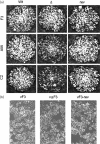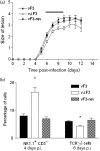Vaccinia virus gene F3L encodes an intracellular protein that affects the innate immune response
- PMID: 17554022
- PMCID: PMC2884953
- DOI: 10.1099/vir.0.82815-0
Vaccinia virus gene F3L encodes an intracellular protein that affects the innate immune response
Abstract
The Vaccinia virus BTB/kelch protein F3 has been characterized and its effects on virus replication in vitro and virus virulence in vivo have been determined. The loss of the F3L gene had no effect on virus growth, plaque phenotype or cytopathic effect in cell culture under the conditions tested. However, the virulence of a virus lacking F3L in an intradermal model was reduced compared with controls, and this was demonstrated by a significantly smaller lesion and alterations to the innate immune response to infection. The predicted molecular mass of the F3 protein is 56 kDa; however, immunoblotting of infected cell lysates using an antibody directed against recombinant F3 revealed two proteins of estimated sizes 37 and 25 kDa.
Figures



Similar articles
-
Vaccinia virus kelch protein A55 is a 64 kDa intracellular factor that affects virus-induced cytopathic effect and the outcome of infection in a murine intradermal model.J Gen Virol. 2006 Jun;87(Pt 6):1521-1529. doi: 10.1099/vir.0.81854-0. J Gen Virol. 2006. PMID: 16690916
-
Vaccinia virus protein K7 is a virulence factor that alters the acute immune response to infection.J Gen Virol. 2013 Jul;94(Pt 7):1647-1657. doi: 10.1099/vir.0.052670-0. Epub 2013 Apr 11. J Gen Virol. 2013. PMID: 23580427 Free PMC article.
-
The vaccinia virus kelch-like protein C2L affects calcium-independent adhesion to the extracellular matrix and inflammation in a murine intradermal model.J Gen Virol. 2003 Sep;84(Pt 9):2459-2471. doi: 10.1099/vir.0.19292-0. J Gen Virol. 2003. PMID: 12917467
-
Vaccinia Virus Protein C6: A Multifunctional Interferon Antagonist.Adv Exp Med Biol. 2018;1052:1-7. doi: 10.1007/978-981-10-7572-8_1. Adv Exp Med Biol. 2018. PMID: 29785476 Review.
-
Vaccinia virus immune evasion: mechanisms, virulence and immunogenicity.J Gen Virol. 2013 Nov;94(Pt 11):2367-2392. doi: 10.1099/vir.0.055921-0. Epub 2013 Sep 2. J Gen Virol. 2013. PMID: 23999164 Review.
Cited by
-
Poxviral ANKR/F-box Proteins: Substrate Adapters for Ubiquitylation and More.Pathogens. 2022 Aug 3;11(8):875. doi: 10.3390/pathogens11080875. Pathogens. 2022. PMID: 36014996 Free PMC article. Review.
-
Poxvirus Interactions with the Host Ubiquitin System.Pathogens. 2021 Aug 16;10(8):1034. doi: 10.3390/pathogens10081034. Pathogens. 2021. PMID: 34451498 Free PMC article. Review.
-
Poxvirus exploitation of the ubiquitin-proteasome system.Viruses. 2010 Oct;2(10):2356-2380. doi: 10.3390/v2102356. Epub 2010 Oct 19. Viruses. 2010. PMID: 21994622 Free PMC article.
-
Ectromelia virus encodes a BTB/kelch protein, EVM150, that inhibits NF-κB signaling.J Virol. 2014 May;88(9):4853-65. doi: 10.1128/JVI.02923-13. Epub 2014 Feb 12. J Virol. 2014. PMID: 24522926 Free PMC article.
-
Monkeypox virus: The changing facets of a zoonotic pathogen.Infect Genet Evol. 2022 Nov;105:105372. doi: 10.1016/j.meegid.2022.105372. Epub 2022 Oct 4. Infect Genet Evol. 2022. PMID: 36202208 Free PMC article. Review.
References
-
- Adams, J., Kelso, R. & Cooley, L. (2000). The kelch repeat superfamily of proteins: propellers of cell function. Trends Cell Biol 10, 17–24. - PubMed
-
- Alcami, A. & Smith, G. L. (1992). A soluble receptor for interleukin-1β encoded by vaccinia virus: a novel mechanism of virus modulation of the host response to infection. Cell 71, 153–167. - PubMed
-
- Angers, S., Thorpe, C. J., Biechele, T. L., Goldenberg, S. J., Zheng, N., MacCoss, M. J. & Moon, R. T. (2006). The KLHL12-Cullin-3 ubiquitin ligase negatively regulates the Wnt-β-catenin pathway by targeting Dishevelled for degradation. Nat Cell Biol 8, 348–357. - PubMed
-
- Bardwell, V. J. & Treisman, R. (1994). The POZ domain: a conserved protein-protein interaction motif. Genes Dev 8, 1664–1677. - PubMed
-
- Beard, P. M., Froggatt, G. C. & Smith, G. L. (2006). Vaccinia virus kelch protein A55 is a 64 kDa intracellular factor that affects virus-induced cytopathic effect and the outcome of infection in a murine intradermal model. J Gen Virol 87, 1521–1529. - PubMed
Publication types
MeSH terms
Substances
Grants and funding
LinkOut - more resources
Full Text Sources
Miscellaneous

